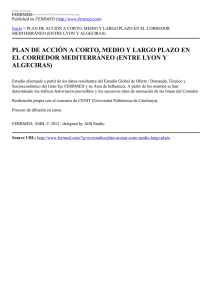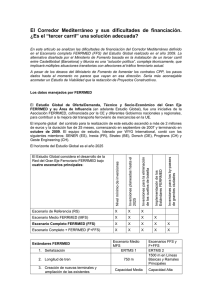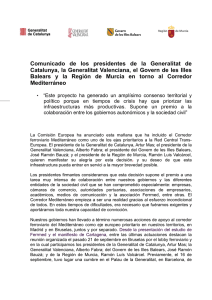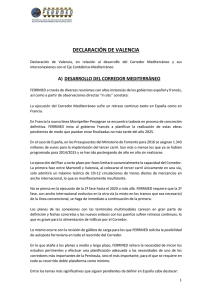PPT - Cierval
Anuncio
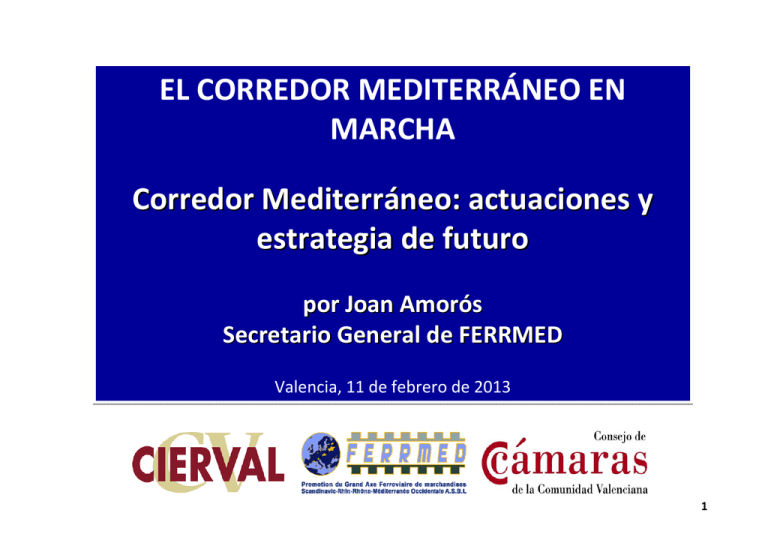
EL CORREDOR MEDITERRÁNEO EN MARCHA Corredor Mediterr áneo: actuaciones y Corredor Mediterráneo: actuaciones y estrategia de futuro por Joan Amorós por Joan Amorós Secretario General de FERRMED Valencia, 11 de febrero de 2013 1 Los porqués de FERRMED (1) Problemas concretos: ¾ Costes logísticos externos (transporte) elevados. ¾ Transporte ferroviario internacional mercancías inoperante. de ¾ Falta de definición de una red prioritaria de transporte ferroviario de mercancías. ¾Olvido de corredores fundamentales como, por ejemplo, el Corredor Mediterráneo. © FERRMED asbl (J. Amorós) I. SUMMARY of the Global Study 2 LA COMPETITIVIDAD EUROPEA FUNDAMENTO DE LOS PROYECTOS DE FERRMED LA LOGÍSTICA COMPRENDE UNA PROPORCIÓN SUBSTANCIAL DEL PRECIO DEL PRODUCTO © FERRMED asbl (J. Amorós) 3 Los porqués de FERRMED (2) Oportunidades: ¾Definición de un “Core Network” ferroviario a nivel de la EU. ¾Coordinación y control del “Core Network” de forma global. ¾Aplicación de los Estándares FERRMED en el “Core Network” ¾Inclusión del Corredor Mediterráneo en el “Core Network” ¾Lograr que las actuaciones propuestas por FERRMED se lleven a cabo © FERRMED asbl (J. Amorós) I. SUMMARY of the Global Study 4 Las acciones de FERRMED Realización de Estudios, Conferencias, Simposios, etc. y propuestas concretas en el desarrollo de la red ferroviaria transeuropea Contactos permanentes con: ¾ Naciones Unidas ¾ Comisión Europea ¾ Parlamento Europeo ¾ Estados miembros de la UE ¾ Regiones miembros de la UE ¾ Ciudades del área de influencia del Gran Eje FERRMED ¾ Países del Norte de África ¾ Instituciones y asociaciones diversas de amplio alcance ¾ Medios de comunicación © FERRMED asbl (J. Amorós) I. SUMMARY of the Global Study 5 Logros alcanzados Aceptación de las propuestas de FERRMED por parte de la COMISIÓN EUROPEA y ESTADOS MIEMBROS, en lo que atañe a: ¾ Definición de una Red Central Ferroviaria Transeuropea ¾ Inclusión en la Red Central (Core Network) de las líneas del tronco principal del Gran Eje FERRMED incorporando, en la parte Sur, el Corredor Mediterráneo al completo ¾ Aplicación de los Estándares FERRMED en la Red Central Transeuropea (en todas sus facetas salvo en la longitud y peso máximo de los trenes) ¾ Gran prestigio de FERRMED en toda la Unión Europea © FERRMED asbl (J. Amorós) I. SUMMARY of the Global Study 6 EJEMPLOS DE ACCIONES CONCRETAS (1) FERRMED MANIFESTO CONFERENCE © FERRMED asbl (J. Amorós) I. SUMMARY of the Global Study 7 EJEMPLOS DE ACCIONES CONCRETAS (2) FERRMED CLUSTER CONFERENCE © FERRMED asbl (J. Amorós) I. SUMMARY of the Global Study 8 EJEMPLOS DE ACCIONES CONCRETAS (3) FERRMED CONFERENCE: “El Corredor Mediterráneo: Impacto socioeconómico en su área de influencia” © FERRMED asbl (J. Amorós) I. SUMMARY of the Global Study 9 FERRMED STANDARDS FOR THE EU RAIL FREIGHT CORE NETWORK (I) (SIMPLIFIELD VERSION) ¾ EU Reticular and polycentric network with great socio-economic and intermodal impact, with two parallel rail lines (double track each) in each main corridor : ¾ one for conventional trains at same priority rate for freight and passengers. ¾ another available for passengers and light freight (high speed trains). ¾ Loading gauge UIC-C, width of the tracks UIC (1435mm). Electrified lines. Maximum slope 12‰. Axle load: 22,5÷25 tonnes. Huge Cities by-passes. ¾ Trains length 1500 m. and 3600÷5000 tonnes. ¾ Locomotive and wagon new concept. ¾ Availability of a network of intermodal polyvalent and flexible terminals. ¾ Unified labour, management and operational systems. ¾ Free Competition. ¾ Favourable and homogeneous fees for the use of infrastructures. ¾ 30÷35% of participation of rail in long distance land transportation. ¾ Unified coordination at EU level of the economic funds allocation for Railway Core Network development and common standards implementation. © FERRMED asbl (J. Amorós) I. SUMMARY of the Global Study 10 FERRMED STANDARDS FOR THE EU RAIL FREIGHT CORE NETWORK (II) This is a key in order to get the competitiveness of the TransEuropean Core Network. Interoperability is a main point, but we have to achieve this interoperability improving, as well, the rail freight capacity and the profitability of the network. In fact, as FERRMED demonstrates in the Global Study already made, the application of FERRMED Standards is the only way to reverse the decreasing share of Railway in EU land transportation and to increase its competitiveness. For all these reasons, we strongly recommend the gradual implementation of FERRMED Standards in the EU Railway Core Network, starting for key corridors, with lead times clearly determined and with full commitment by the Member States. © FERRMED asbl (J. Amorós) 11 FERRMED STANDARDS FOR THE EU RAIL FREIGHT CORE NETWORK (III) Length of trains Average of usual train length in EU network: 400- 450 meters FERRMED proposes to increase maximum authorized train length up to 1500 meters Such a proposal needs the whole Core Network to be modified: • Sidings • Intermodal terminals • Ports connections • Railway freight stations American train Execution step by step within the Trans-European Core Network: • Trains of 750 m length • Trains of 1000 m length • Trains of 1500 m length © FERRMED asbl (J. Amorós) European train I. SUMMARY of the Global Study 12 FERRMED STANDARDS FOR THE EU RAIL FREIGHT CORE NETWORK (IV) Maximum slope Significant slopes: • Reduce train carried load because of breaking and starting reasons • More powerful locomotives are needed • Engender longer travelling times FERRMED proposes that the slopes do not exceed 12mm/m (exceptionally 15 mm/m between short distances of hundreds of meters only) © FERRMED asbl (J. Amorós) I. SUMMARY of the Global Study 13 FERRMED STANDARDS FOR THE EU RAIL FREIGHT CORE NETWORK (V) Width of the track UIC (1.435 mm) © FERRMED asbl (J. Amorós) 14 FERRMED STANDARDS FOR THE EU RAIL FREIGHT CORE NETWORK (VI) Loading Gauge UIC – C © FERRMED asbl (J. Amorós) I. SUMMARY of the Global Study 15 TRANSFER FROM ROAD TO RAIL BASED ON MODALOHR TECHNOLOGY (LORRY RAIL) (I) © FERRMED asbl (J. Amorós) 16 TRANSFER FROM ROAD TO RAIL BASED ON MODALOHR TECHNOLOGY (LORRY RAIL) (II) © FERRMED asbl (J. Amorós) 17 FERRMED FREIGHT LOCOMOTIVE CONCEPT The aim of this Study is to define the minimum design parameters that the EU locomotives should have to fulfil the FERRMED Standards, particularly long and heavy trains. FERRMED Trains Characteristics Length 1.500m Track gauge 1435 mm Loading gauge UIC C Gross Weight = Load 3.600 t – 5.000t Number of motorized axles 12 axles Number of locomotives More than one: 2 Co-Co or 3 Bo-Bo Starting tractive effort of the train 600 kN – 800 kN Power of the train 7.000 kW – 10.000 kW FERRMED Locomotives Characteristics Starting tractive effort of the locomotive 300 kN – 400 kN Power of the locomotive 3.500 kW – 5.000 kW Axle load Axle arrangement 22,5 t/axle – 25 t/axle Co-Co or Bo-Bo Maximum speed Adhesion coefficient (µo) 120 Km/h At least 33% Type of traction Diesel locomotive or electrical multi-tension locomotive Coupling Automatic with capability to connect current UIC screw couplers and Russian couplers. Brake E-ECP Brake System (Enhanced-Electronically controlled pneumatic system) Interoperability YES. Fulfillment all applicable TSI and other European Directives Safety and Signaling system Train control system Radio system ERTMS ETCS GSM-R Cab 2 cabs with central desk ensuring safety and comfort of the driver © FERRMED asbl (J. Amorós) I. SUMMARY of the Global Study 18 FERRMED FREIGHT WAGON CONCEPT Platform concept (several wagon types can be demanded/detachable superstructures Three basic designs: Design A1: Long wagon → mainly for intermodal/volume-cargo (25m of loading length) Design A2: Short wagon → for bulk and break-bulk commodities Design B: Flat wagon for trailer Transport Key parameters: Axle load 22,5 ÷ 25 tons; Loading gauge: UIC-GC; Speed: 100÷ 120 km/h.; Central beam; Automatic central couplers; Electric power Supply/ IT equipment; compact brakes Main advantages: A1: More capacity when loaded with containers. Better adapted to 40’ containers. 50% more capacity when loaded with C-Swap bodies B: handles 100% of European semi-trailer fleet © FERRMED asbl (J. Amorós) 19 EMERGENT MEDITERRANEAN MAIN WORLD CONTAINER TRAFFICS (2009) Far East-Europe → 16,8 Million TEUS Trans-Pacific → 16,7 Million TEUS Trans-Atlantic → 4,7 Million TEUS Given that container traffic is expected to increase by 64% by 2020, Mediterranean Ports should be able to increase their share in flows between Far-East and Europe by 35 ÷ 40% (Present share with Northern Sea Ports is only 23%). Good railway links of ports with hinterlands and among ports is a key to reach such increase in share. © FERRMED asbl (J. Amorós) 20 LAS CONEXIONES DE MARRUECOS CON LA UNIÓN EUROPEA El Corredor Mediterráneo es el camino más corto para llegar a la Europa Central y del Este. Desde Algeciras hay unos 475 Kms menos que por el Corredor Central/Atlántico. Con un coste aproximado de 0,042 Euros/Tonelada-Km, para un tren de 1000 toneladas netas de carga, serian unos 20.000 euros de diferencia por trayecto © FERRMED asbl (J. Amorós) 21 LA COMPETITIVIDAD EUROPEA FUNDAMENTO DE LOS PROYECTOS DE FERRMED THE EUROPEAN MEGA-REGIONS ECONOMIC ACTIVITY GENERATION IN THE GREAT EUROPEAN MEGAREGIONS based in spatial techniques and statistics as well as in light emission (LRP) (according to Richard Florida) The figures express the sequential order of economic output at world world wide level © FERRMED asbl (J. Amorós) 22 L’AXE MÉDITERRANÉEN IBÉRIQUE LA MEILLEURE SOLUTION POUR REJOINDRE LES PRINCIPAUX FLUX LOGISTIQUES EN FRANCE CARTE DES PRINCIPAUX FLUX LOGISTIQUES EN FRANCE Source: Logistique magazine © FERRMED asbl (J. Amorós) 23 EL SECTOR SUR DEL GRAN EJE FERRMED EL CORREDOR MEDITERRÁNEO LYON‐ALGECIRAS © FERRMED asbl (J. Amorós) 24 ACTIONS QUE FERRMED RÉCLAME POUR LE CORRIDOR MÉDITERRANÉEN Secteur Frontiére franco-italienne – Lyon – Frontiére francoespagnole COURT TERME 2012-2015 Amélioration de la ligne actuelle Montpellier-Perpignan Mise à niveau de la ligne Valence-Grenoble Amélioration de la capacité des infrastructures et de terminaux ferroviaires du Port de Marseille (phases 1 et 2) Commencement des travaux du tunnel de base de la Transalpine (Lyon – Turin) INVESTISSEMENT : 2.610 M€ MOYEN TERME 2016-2020 Contournement Est de Lyon (secteur Nord) Contournement dans le secteur Nîmes-Montpellier Amélioration de la capacité des infrastructures et de terminaux ferroviaires du Port de Marseille (phases 3) Lyon – Turin Début des travaux de l’accès français au tunnel de base depuis Lyon et continuation du tunnel de base Contournement Est de Lyon (Secteur Sud) Nouvelle ligne Montpellier-Perpignan Amélioration du gabarit de charge ligne Perpignan – Cerbère Contournement Est de Lyon (Secteur Sud) INVESTISSEMENT : 13.800 M€ LONG TERME 2021-2025/2030 Finalisation de la nouvelle ligne transalpine Lyon-Turin (secteur Lyon-frontière franco-italienne) INVESTISSEMENT : 5.600 M€ © FERRMED asbl (J. Amorós) 25 ACCIONES QUE FERRMED RECLAMA EN EL CORREDOR MEDITERRÁNEO (I) SECTOR PORTBOU - ALGECIRAS CORTO PLAZO 2012-2015 • Ancho de vía internacional en toda la línea convencional desde Portbou hasta Cartagena • Vía doble entre Tarragona y Vandellós • Conexiones con los puertos, aeropuertos y terminales multimodales, adaptación de los nodos logísticos más importantes y trenes de 750 m. • Circunvalación Valencia Sector Sur (Fuente de San Luis – Almusafes – Benifaió) ¾ INVERSIÓN: 3.740 M€ © FERRMED asbl (J. Amorós) 26 ACCIONES QUE FERRMED RECLAMA EN EL CORREDOR MEDITERRÁNEO (II) SECTOR PORTBOU – ALGECIRAS MEDIO PLAZO 2016-2020 • Remodelación de la línea convencional Font La Figuera – Monforte – Murcia – Lorca – Almendricos en vía doble y doble vía Murcia – Cartagena •Circunvalaciones de Barcelona (Nudo Castellbisbal – Martorell), Valencia (Almusafes – Sagunto: Variante Oeste o túnel pasante) y Murcia • Línea de Alta Velocidad Tarragona – Castelló • Adecuación gálibos de carga y ampliación de plataformas logísticas (terminales multimodales) • Duplicación de las líneas donde sea necesario • Nueva línea mixta (altas prestaciones) Málaga - Algeciras ¾ INVERSIÓN: 9.523 M€ © FERRMED asbl (J. Amorós) 27 ACCIONES QUE FERRMED RECLAMA EN EL CORREDOR MEDITERRÁNEO (III) SECTOR PORTBOU – ALGECIRAS LARGO PLAZO 2021-2030 • Circunvalaciones de Barcelona (Sant Celoni – Castellbisbal) y de Valencia (Castelló – Xàtiva) • Nueva línea de mercancías Martorell – Tarragona • Nueva línea mixta (altas prestaciones) Almería – Motril – Málaga • Nueva línea mixta (altas prestaciones) Lorca – Baza – Granada • Nuevas terminales y completar circunvalaciones • Implantación “al completo” de los Estándares FERRMED ¾INVERSIÓN: 12.000 M€ © FERRMED asbl (J. Amorós) 28 FERRMED GLOBAL STUDY IMPACTO ECONÓMICO EN ESPAÑA Y EN FRANCIA Ahorros en millones de Euros (periodo 2016-2045) Concepto Global Red Banana España 18,2% Corredor Mediterráneo 70% España France 31,6% Couloir Méditerranéen 27% France VOC 228.000 41.496 29.047,2 72.048 19.453 Savings in transport lead time 285.000 51.870 36.309 90.060 24.316 Emissions 15.000 2.730 1.911 4.740 1.280 528.000 96.096 67.267,2 166.848 45.049 ∑ EIRR=11,1% Nota.- 1). Cálculos realizados considerando la longitud de la Red Ferroviaria Principal del Gran Eje FERRMED. 2). Impacto en PIB no considerado (puede ser alrededor de un 1% de incremento cada año en los primeros 10 años. © FERRMED asbl (J. Amorós) 29 DESARROLLO DEL CORREDOR MEDITERRÁNEO IMPACTO EN LA ACTIVIDAD LOGÍSTICA Datos de partida • Incremento del tráfico intercontinental del 64% (2010-2020) • Evolución de la proporción tráficos intercontinentales entre Mar del Norte y el Mediterráneo Occidental del 77% - 23% al 65% - 35% Impacto • Incremento tráfico portuario intercontinental del 100% (2020) • Necesidad adicional de espacio para las plataformas logísticas del 56% (2025) © FERRMED asbl (J. Amorós) 30 ACCIONES EN EL CORREDOR MEDITERRÁNEO ADECUACIÓN TERMINALES EXISTENTES Y CONSTRUCCIÓN DE NUEVAS TERMINALES CORTO PLAZO 2013-2016 MEDIO PLAZO 2017-2025 • El Far – Empordà • Área del Penedès • La Llagosta • Área de Constantí • Port de Barcelona • Área de Montblanc • Puerto de Castelló • ZAL de Cartagena – El Gorguel • Puerto de Sagunto / Parc Sagunt • Zona de Lorca – Puerto Lumbreras • Fuente de San Luis • Zona de Almería • Puerto de Valencia • Zona de Motril • Puerto de Alicante • Zona de Málaga • ZAL de Murcia • Zona de Granada • Zona de Antequera • Desarrollo terminales en los • Zona de Algeciras polígonos industriales más • Desarrollo terminales en los polígonos importantes (2ª fase) industriales más importantes (1ª fase) © FERRMED asbl (J. Amorós) 31 CORREDOR MEDITERRÁNEO TRÁFICO TRANSFRONTERIZO EN LOS PIRINEOS ORIENTALES EN MILLONES DE TONELADAS En millones de toneladas Año 2005 Año 2025 Carretera 50,2 71,5 Tren 2,5 (4,7% del tráfico total) 38,5 (35% del tráfico total) * Total 52,7 110 *Esta cifra equivale a 214 trenes de 500 toneladas netas al día, o a 107 trenes de mil toneladas netas al día o a 53,5 trenes de dos mil toneladas netas al día. Las líneas ferroviarias del Corredor Mediterráneo, con las acciones previstas en el Estudio Global y en las propuesta de FERRMED, admIten sobradamente el 35% del tráfico terrestre total y pueden absorber sin problemas un balance de tráfico marítimo Norte-Sur del 65÷35% (e incluso 60÷40). © FERRMED asbl (J. Amorós) 32 CORREDOR MEDITERRÁNEO (TRÁFICO TRANSFRONTERIZO EN LOS PIRINEOS ORIENTALES) (Número de camiones y número de trenes equivalentes) Concepto AÑO 2005 AÑO 2025 Camiones 3.400.000 4.842.000 Trenes 500 tn/netas 14 214 Trenes 1000 tn/netas 7 107 Trenes de 1500 tn/netas 4,6 71,3 Ahorro en emisiones CO2 ~ 1.000.000 Tn/año (promedio 2016-2045) © FERRMED asbl (J. Amorós) 33 LA FINANCIACIÓN DE LAS INVERSIONES 9Las inversiones que FERRMED reclama en el Corredor Mediterráneo, llevan unos 20 años de retraso. 9En una situación de crisis como la actual, las inversiones en infraestructuras se han de priorizar donde se obtiene una mayor rentabilidad socio-económica, como es el caso del Corredor Mediterráneo (primero invertir donde se genera riqueza y después tener en cuenta la cohesión territorial y no al revés). 9Invertir en el Corredor Mediterráneo es una solución, que no podemos desaprovechar, para rehacer la maltrecha economía española. 9En cualquier caso, la elevada rentabilidad de una buena parte de las inversiones necesarias, permite perfectamente la financiación públicoprivada. © FERRMED asbl (J. Amorós) 34 CRITERIOS DE PRIORIDAD NUEVA INVERSIÓN EN LA UE En la U.E., se está yendo hacia una nueva dimensión socioeconómica siguiendo tres grandes vectores emergentes de desarrollo empresarial: ¾Vector EULER’s (FERRMED) ¾Vector Mediterráneo ¾Vector Euro-Asiático El crecimiento de nuestro bienestar socioeconómico tiene que estar totalmente orientado hacia estos tres vectores emergentes “abiertos”. © FERRMED asbl (J. Amorós) 35 INSERCIÓN DEL CORREDOR MEDITERRÁNEO EN LOS “FULL FERRMED CORRIDORS” FERRMED propone seleccionar en el “Trans-European Core Network” definido por la Comisión Europea unos pocos corredores Norte-Sur y Este-Oeste que interrelacionen los puertos y las zonas industriales y logísticas más importantes (de 10.000 a 12.000 Kms, frente a los cerca de 70.000 Kms del Core Network propuesto por la CE y Estados miembros) En estos corredores (Full FERRMED Corridors) deberían implantarse los Estándares FERRMED al completo, con trenes de hasta 1.500 m de longitud y 5.000 toneladas de peso bruto. Fecha límite considerada: año 2030 FERRMED solicita que, en las líneas seleccionadas, se prevean las correspondientes vías de apartado aptas para trenes de esta longitud. Las Terminales deben preverse con vías de longitud mínima de 750 m (lo que permite partir un tren largo en dos). En paralelo, debe iniciarse un PLAN RENOVE para adaptar los vagones de mercancías a las nuevas necesidades. © FERRMED asbl (J. Amorós) 36 PRÓXIMA FERRMED CONFERENCE FERRMED Conference “LONG AND HEAVY TRAINS, THE WAY TO EU RAIL FREIGHT COMPETITIVENESS” EU Parliament Hall JAN 4Q1 Brussels March 6th, 2013 © FERRMED asbl (J. Amorós) 37 FERRMED ASBL Muchas gracias por su atención © FERRMED asbl (J. Amorós) 38
